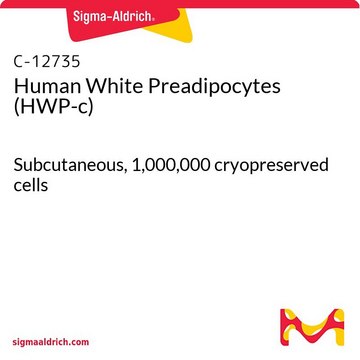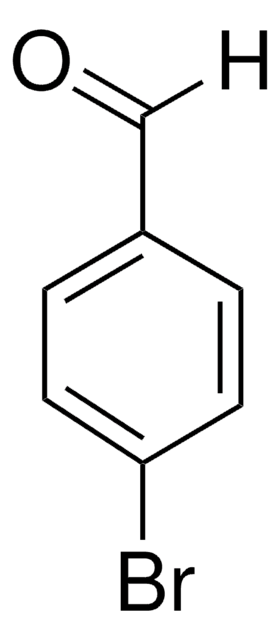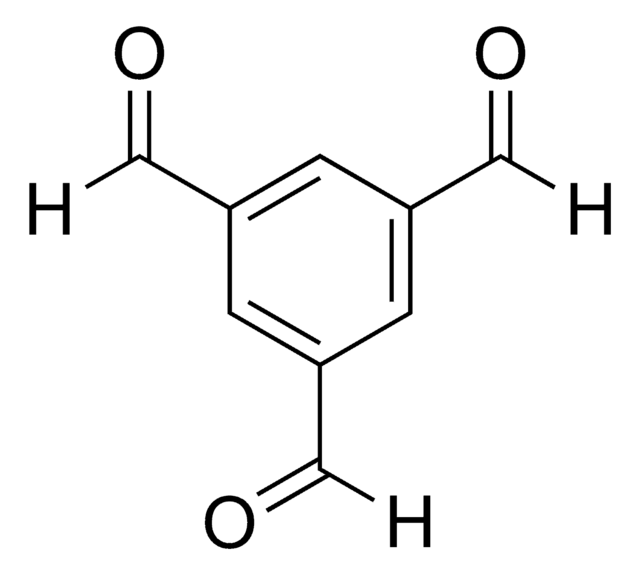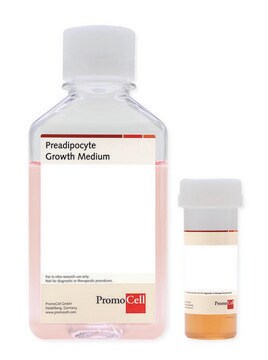802S-05A
Human Preadipocytes: HPAd, adult subcutaneous
Sinonimo/i:
HPAd, HPAd cells
About This Item
Prodotti consigliati
Origine biologica
human adipose tissue (normal)
Confezionamento
pkg of 500,000 cells
Produttore/marchio commerciale
Cell Applications, Inc
Modalità di accrescimento
Adherent
Cariotipo
2n = 46
Morfologia
Fibroblast-like
tecniche
cell culture | mammalian: suitable
Malattie correlate
diabetes; obesity; cardiovascular diseases
Condizioni di spedizione
dry ice
Temperatura di conservazione
−196°C
Descrizione generale
Most research in adipocyte biology was conducted in mouse 3T3-L1 cell lines. It has been impossible to use human adipocytes because they die within 24 hours after isolation. Primary Human Preadipocytes (HPAd) are derived from human subcutaneous adipose tissue at various sites and adipose depot on the heart. These fibroblast-like precursor cells are cryopreserved at the end of primary culture and can be propagated two passages prior to differentiating into Human Adipocytes (HAd). Complete differentiation can be easily achieved through the use of Adipocyte Differentiation Medium. Mature HAd are expected 10 days after induction of differentiation and should remain healthy and responsive for at least 2 weeks after complete differentiation. Adipose mass can be controlled by inhibition of HPAd differentiation and increase of lypolysis. HAd are ideal cellular models for drug discovery research in the area of obesity, diabetes and cardiovascular diseases.
HPAd have been used in multiple studies investigating the cellular basis of diabetes and obesity, as well as mechanisms of action of various drug candidates. For example, it was shown that interaction between infiltrating monocytes and adipocytes affects production of metalloproteinases and osteopontin, a proinflammatory cytokine, which ultimately leads to development of more adipose tissue and insulin resistance (Samuvel, 2010, 2011). It was further demonstrated that adipocyte differentiation requires activation of Akt1 through the mTORC2-BSTA mechanism, leading to downstream suppression of FoxC2 (Yao, 2013). Instead of protecting from hyperglycemia-induced ER stress, like it does in other cells, in adipocytes a bioactive, endogenously produced compound taurine was shown to modulate the expression of adipokines under inflammatory conditions by inhibiting the STAT-3 signaling pathway (Kim, 2013a,c), and to inhibit differentiation of preadipocytes into adipocytes (Kim, 2013b). Additionally, FGF21, which leads to reduction of body weight in animal models of obesity, was shown to act by modulating gene expression, phosphorylating Frs2a, Erk1/2, and Mypt1 (Muise, 2013) and by increasing oxidative capacity of adipocytes via AMPK–SIRT1–PGC1a cascade (Chau, 2010). Similarly, atrial natriuretic peptide (ANP) was shown to regulate lipid catabolism and reduce insulin resistance in HPAd by activating AMPK (Souza, 2011). HPAd were also used to study adipocytokines in normal pregnancy and pregnancy-induced hypertension (Naruse, 2011), and to investigate the anti-obesity and hypolipidaemic properties of lotus seed extract (You, 2013, 2014). Finally, HPAd (along with Human Dermal Fibroblasts) have been used to demonstrate the role of epigenetic modifications in increasing efficiency of iPS reprogramming (Rim, 2012).
Origine della linea cellulare
Applicazioni
Componenti
Nota sulla preparazione
- 2nd passage, >500,000 cells in Preadipocyte Cell Basal Medium that contains 20% FBS and 5% DMSO
- Can be cultured 2 passages before differentiation into HAd
Mantenimento delle subcolture
Esclusione di responsabilità
Codice della classe di stoccaggio
11 - Combustible Solids
Classe di pericolosità dell'acqua (WGK)
WGK 3
Punto d’infiammabilità (°F)
Not applicable
Punto d’infiammabilità (°C)
Not applicable
Certificati d'analisi (COA)
Cerca il Certificati d'analisi (COA) digitando il numero di lotto/batch corrispondente. I numeri di lotto o di batch sono stampati sull'etichetta dei prodotti dopo la parola ‘Lotto’ o ‘Batch’.
Possiedi già questo prodotto?
I documenti relativi ai prodotti acquistati recentemente sono disponibili nell’Archivio dei documenti.
Protocolli
Store the cryovials in a liquid nitrogen storage tank immediately upon arrival.
Il team dei nostri ricercatori vanta grande esperienza in tutte le aree della ricerca quali Life Science, scienza dei materiali, sintesi chimica, cromatografia, discipline analitiche, ecc..
Contatta l'Assistenza Tecnica.




